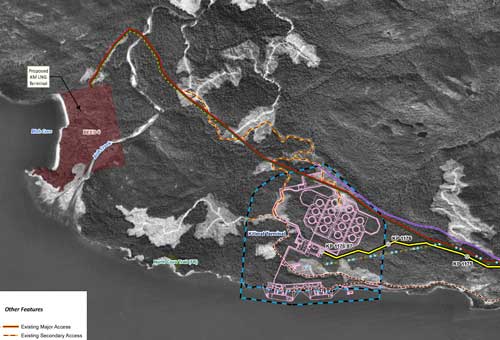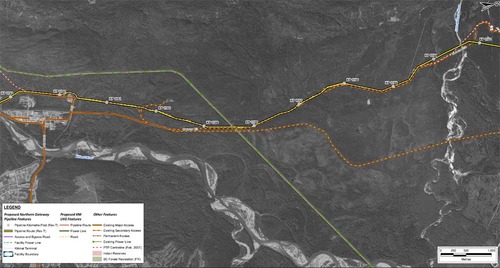This story presents the unfiltered voices of Haisla chiefs when they testified at the Northern Gateway Pipeline Joint Review hearings on January 10, 2011, at Kitamaat Village, based on the official transcript. There have been minor edits for clarity.
My name is Chief Jassee. My English name is Samuel Robinson. I’m from Beaver Clan;

hereditary Chief of the Haisla Nation. I was born here in Kitamaat Village but spent a lot of my childhood days with my father trapping in Wewanee.
The area is rich with all kinds of food; halibut, cod, mussels and all kinds of seafood. There are a lot of fur-bearing animals. This is why I’m really concerned if this is damaged. In Wewa, we have a hot spring there. The first tub was made by my dad and my uncle George, made out of wood. If there’s any kind of spill that will be damaged.
There is a lot of seafood there. There is still a lot of seafood, I know because I’m owner/operator of a fishing charter business for the last 45 years. There are still a lot of fishing charter boats that depend on fishing in the Douglas Channel. I also watch the commercial fishermen. I know every inch of our territory because I’m out there almost every day in the summertime running my business.
I’ll get back to the head of the Kitimat River; this is where my concern starts.
We used to fish the number one reserve for a fish called eulachons, which is now no more because of pollution in the river for the last 30 years. But the river is not dead yet. The salmon still go up there; that’s why we have to protect it. I know we can’t do much about the eulachons now, but the salmon still go up there.
This is our last resort. Thank you for listening to me.
Up the river, we spend our days there, harvesting eulachons. In my childhood days, you didn’t need a net, you didn’t need hook, and you didn’t need anything. You can pick the eulachons out of the water. In fact you could walk across to the other side. That’s how plentiful it was when we were thriving. No more eulachons.
From the eulachon camp, we follow the river down to Kacla’isaa in my language Kacla is, English, “foot of the river.” There on the left-hand side, you’ll see a rock, a figure of a human being. We call it in my language, kwalach; that means sissy. It was used to teach young children, teenagers, not to run away from enemy but to stand up or else you’ll turn into a rock.
That’s what it is used for, to teach our children. This is what I’m concerned about, if it’s covered up with something. You travel down the same river, foot of the river, about a few lengths down you come to another carving, carving on rocks we call handumatsa in my language. It means bow and arrow, hatweegit. That protects the river; that’s what it’s there for.
And you travel down into the sea you come to my village, and at the point called Raley Point, right outside the south end of Kitamaat Village, there is another carving right down the beach, the figure is of a killer whale. You walk along the beach further to a creek called Wart, another carving is there and it’s carved, the figure is a human face. These are all signals that we were here for a long time.
If you look across the bay, right across the Bish Creek there’s another historic site there. We call it Huntclic in my language. It means targeting area. When the raiders come to raid my village they target in this rock. And the old people used to tell me the story — this is just within 100 years. The shafts of the arrows were sticking out. When the white man came here, they heard of it and went to check it and they found the remains of the arrowheads.
You travel down a little ways more and there’s a rock sticking out, the name of it is Kabat Regat. It’s a historical site too that teaches the young kids about sex and all that, what you’ll turn into if you misuse it. Adultery was a no -no in my village and that’s what this was for, to teach the young kids.
You travel down furthermore, you come to a place called Gilttoyees, a long inlet, and on the south mouth of the river — of the inlet you’ll see paintings, paintings of Indian paint telling who owns that area, who was there. And I’m one of the last ones that can read the signs and it makes me — tears come out of my eyes.
You follow the channel; you come to a place called Foch Lagoon. There was a village there — still there, a historic site too that will be affected by whatever damage. These were half human beings and half animals. It’s recorded in our history. We call it Fochfu in my language.
So these are all the places that I’m really worried about.
And you go further down the channel, we go into the Hartley Bay area, there are big boulders there carved in stone. It’s still there. Now I will tell you what the reason is, why these are carved in a tidal water. Most of it is below low water.
The Chief hired helpers to carve these rocks at low tide so when the raiders come in they will be the first one to spot the raiders and warn the Chief to get away. They were also helpers that carved mid-tide; these were done to warn the Chief, early warning, when the raiders come.
These are all the places that I’m worried about. It’s our history and it’s how we teach our children and our teenagers up till today.
And you go up to the Kitlope, at Kemano Village, at the south end of the village there’s another carving, a carving of a human being, a human face, That’s to protect that village from raiders. You go up to Kitlope, at the mouth of the river you’ll see all kinds of paintings telling who owns that place — we own it.
So these are all the things that I’m worried about. If it’s covered up with oil how are we going to protect ourselves? This is my concern.
And getting back to the sisur rock in the mouth of the water. If we — are we going to protect ourselves or are we all going to turn into stone? I don’t know. I’m happy — I’m hoping that doesn’t happen.
So all my area where I trap, where I trap — my dad’s favourite trap, I own it now. There are an abundance of fish there. There’s halibut, all kind of seafood, all kind of birds, all kind of fur animals.
This is what I’m concerned about, because my people, my family and everybody survived on all these animals. Please help us and hear us so we can continue to live the way we are. We are who we are.
I am the 11th Haimus, hereditary Chief of Kitimaat Village. My name is Jassee. I was born into the bloodline; that is why I’m a chief. I did not choose to be a chief. All our lives my brother and I were trained in the role of responsibility as a leader of the Beaver Clan and the Haisla Nation. It just didn’t happen overnight.
I started my training from my grandmother and mother when I was only
12 years old. I know all the history, laws, ins and out of the Native culture. Probably
I’m the last one. So there, hear me, please.
The transfer of my name was done according to custom tradition of our ancestors. The oldest son of the mother is first in line for the title. When he dies the next oldest brother takes over, the son to be, same bloodline clan as the mother.
My brother Tom — the late Tom Robinson, my brother — held this name before me for 50 years. So if you add all the chiefs together it comes to a lot of numbers.
Our nation is subdivided by a clan system according to your mother’s line. The Beaver Clan, the Raven work together. The Eagle Clan, Fish, Salmon, and Killer Whale, each clan is headed by the chief who acts as their leader and all the directions of Jassee of the Beaver Clan. The major benefit of this system keeps history, maintains law, protects family, divides responsibility and education.
During a trauma, a celebration, a major undertaking all clan members provide comfort and support. We know ourselves, Haisla, which means “People Living at the Foot of the River at the South End.” Haisla means “south.” You know we’re in the north but to the Nass Valley people we’re the south people; that’s why we’re called Haisla.
Later the Tshimshian called us Kitamaat, which means “People of the Snow.” We speak part Kwakuit language. Group of why we understand people from clan too, Bellabella, Alert Bay, Macaw from the United States. Our territory is located approximately centre of the north and south border of the west coast of B.C. We are surrounded by other First Nations.
Our territory includes the land and waters surrounding all of Kitimat River, the Douglas Channel up to including Gardner Canal. We know all these places by Haisla name and by the use of their resources.
In the past, during the mid-winter, our people move over gathering and providing food, making tools, building canoes, drying salmon, digging for clams and cockles, collecting roots, berries, plants, medicine; for many other reasons.
We live here in Kitamaat Village which was used as a winter settlement because of the location from extreme weather conditions. My mother, late mother, Laura, was asked how long we have lived here. She motioned with her thumb and her index finger almost together and said: “Since the trees were this small.” That’s my mother.
Judging from the growth of the spruce tree located near the Kitimat River Oolikan camp Housing Site, we have been here for 1,500 to 2,000 years according to the growth of the tree. Our people have travelled various of locations to harvest food, material, trading with other communities up and down the Coast by dugout canoe.
We also travelled by land through the B.C. interior. For example, our people in Kimaloo area travelled over the mountain to trade our eulachon grease with people living in the B.C. interior. Some married there and some of us still have relations living there.
We know our ancestors travelled up and down the West Coast of what is called now “the United States”. Because of our isolat ion, we had to be self-sufficient, depending our ability to utilize our territory resources: the forest for its plants and animals; the river for its varieties of food, seafood, shell fish and other seafood.
Our main source is the salmon which we preserve by the hundreds for each family for immediate use and winter use. It worries me to think all of these will be lost and destroyed when there is a spill. Mark my word, when there is a spill. Experience shows it will happen.
We have always been taught to take only what we need and to leave the harvest site in the same or better manner, condition, which — when we leave the area. This is a global concern to keep everything clean now.
We always have been a peaceful nation but when it isn’t through discussion and negotiation, when all fails, we went to war to protect our family, our rights, our ownership of food, shelter and safety.
When they made our reservations, our Chiefs had very little education; in fact, couldn’t write or read. But we had one stand-out Chief named Sunre. His name was Johnny Bolton. On September 1st, 1913, the Royal Commission interviewed Kitamaat Indian Chief Sunre. Chief Johnny Bolton made the following statement — Chief Johnny Bolton, this is his words:
“We are troubled about our land. It is not straight to us somehow. It is ours because we were born here, our forefathers before us. We want you to understand it. We want to know how Government got the land outside the Reserve. Chairman, we have not anything to do with land outside the Reserve, we have no authority to settle that question at all. It is no use bringing it before us.”
“We are troubled about how the Government has gone and sold our land outside our Reserve. We know it’s our land and not the Government’s and they have gone out and sold it and done what they like with it.”
For that, I don’t want that to happen again. We want to say — we want our say in this process that’s coming up, this pipeline. We will be not walked over again like the way they’ve done on the Reserve system. We want to have a voice and we’re going to have a voice.
Thank you for your kind attention.

 A tanker entering Prince Rupert harbour. (Robin Rowland/Northwest Coast Energy News)
A tanker entering Prince Rupert harbour. (Robin Rowland/Northwest Coast Energy News) On November 16, 2011,
On November 16, 2011,  On November 17, 2011,
On November 17, 2011,  On Nov. 22,
On Nov. 22, On Nov. 23, ACM Shipping, a British company, told
On Nov. 23, ACM Shipping, a British company, told  Dieter Wagner, of Douglas Channel Watch, briefs District of Kitimat Council on the perils of Wright Sound, Oct. 17, 2011. (Robin Rowland/Northwest Coast Energy News)
Dieter Wagner, of Douglas Channel Watch, briefs District of Kitimat Council on the perils of Wright Sound, Oct. 17, 2011. (Robin Rowland/Northwest Coast Energy News)


 In this map, the Enbridge pipeline is yellow with a black outline, the LNG pipeline is red. Where there are yellow and red alternating squares, that means the two pipelines will follow the same route. Solid orange lines are paved roads,broken orange lines are unpaved roads and the green lines are power lines.
In this map, the Enbridge pipeline is yellow with a black outline, the LNG pipeline is red. Where there are yellow and red alternating squares, that means the two pipelines will follow the same route. Solid orange lines are paved roads,broken orange lines are unpaved roads and the green lines are power lines. Just before the pipelines reach the service centre, they diverge, the yellow Enbridge pipeline following the road route around the periphery of the service centre, while the gas pipeline at first follows the route of the Pacific Trails Pipeline and then snakes off at the hydro substation. The two pipelines then run parallel just off Haisla Boulevard across from the Rio Tinto Alcan plant. The green line beside the two pipelines marks a hydro line that would be build to power the facilities.
Just before the pipelines reach the service centre, they diverge, the yellow Enbridge pipeline following the road route around the periphery of the service centre, while the gas pipeline at first follows the route of the Pacific Trails Pipeline and then snakes off at the hydro substation. The two pipelines then run parallel just off Haisla Boulevard across from the Rio Tinto Alcan plant. The green line beside the two pipelines marks a hydro line that would be build to power the facilities. The final map shows the Enbridge pipeline coming into the bitumen/condensate terminal with its large footprint, while the natural gas pipeline continues, crosses Bish Creek and then enters the Bish Cove KM LNG terminal. If the BC LNG terminal is built at North Cove, just west of the proposed Enbridge Northern Gateway facility, a branch pipeline would go from the main gas pipeline down to that facility. (There were indications at the June NEB hearings that negotiations were under way on “sharing” gas “molecules” between the two groups).
The final map shows the Enbridge pipeline coming into the bitumen/condensate terminal with its large footprint, while the natural gas pipeline continues, crosses Bish Creek and then enters the Bish Cove KM LNG terminal. If the BC LNG terminal is built at North Cove, just west of the proposed Enbridge Northern Gateway facility, a branch pipeline would go from the main gas pipeline down to that facility. (There were indications at the June NEB hearings that negotiations were under way on “sharing” gas “molecules” between the two groups). Footprint of the Enbridge Northern Gateway plant.
Footprint of the Enbridge Northern Gateway plant.